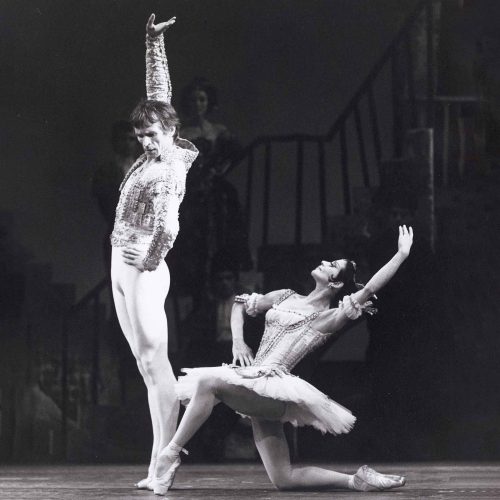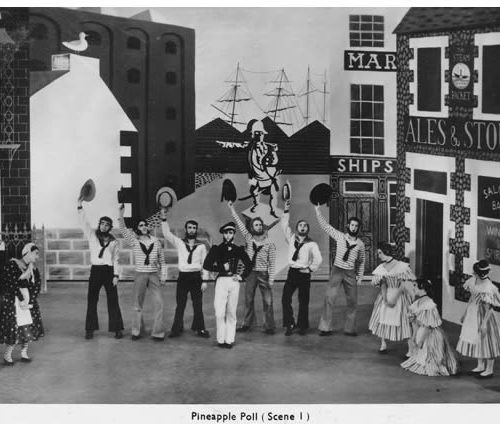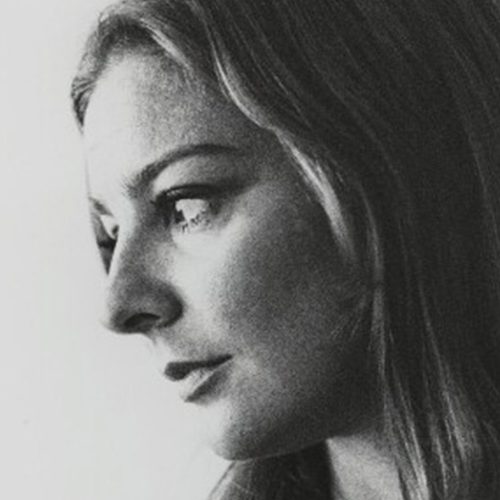Lucette Aldous
You can hear in her voice how much Lucette Aldous appreciated and revelled in every step of her way from Ballet Rambert to Festival Ballet and The Royal Ballet. With comments as swift as an arrow, watch out for a fascinating glimpse of the young Kenneth MacMillan and later the mindfulness of the much older John Field. In conversation with Patricia Linton, Lucette speaks about joining – and then leaving – Ballet Rambert; about working in Festival Ballet with John Gilpin and being taken under Anton Dolin’s wing, especially for Giselle; about how, when she went to The Royal Ballet, Field ‘wrapped his ballerinas in cotton wool’; and about how MacMillan’s earlier approach to choreography differed in his later ballets. The interview is introduced by Deborah Weiss.
First published: October 7, 2025
Biography
Lucette Aldous was born in New Zealand in 1939, but lived in Sydney, Australia, from the age of three months. After studying in Sydney, she won a scholarship to study at The Royal Ballet School in 1955. She joined Ballet Rambert in 1957, being promoted to ballerina in 1958. She went to Festival Ballet in 1963, dancing with John Gilpin, and then in 1967, at the behest of John Field, to The Royal Ballet.
Aldous returned to Australia in 1970 and joined The Australian Ballet. When there she was invited to work with the Kirov Ballet, one of the first Australian dancers to be so honoured. Acclaimed in many ballerina roles of all parts of the repertoire, her partnerships with Rudolf Nureyev in The Nutcracker for The Royal Ballet and in Don Quixote for The Australian Ballet were noteworthy. She retired from dancing in 1976, subsequently teaching in Perth, Western Australia. In 2018 Lucette Aldous was made a Companion of the Order of Australia. She died in 2021.
Transcript
in conversation with Patricia Linton
Lucette Aldous: When we came back to Sydney, we went to a very famous ballet school that Kathy Gorham had gone through, and Elaine Fifield. They were all en pointe and turning at 14. I was only just en pointe. Anyway, I persevered, and wonderful Kathleen Daintree said, ‘Lucette is going to win the scholarship, and go to England.’ So, I did win the scholarship. Bobby Helpmann was in town with Kate [Katharine] Hepburn doing The Merchant of Venice and The Taming of the Shrew with her. And my father happened to be talking to an old friend and mentioned me, that I might be going to England. He said, ‘She must meet Bobby Helpmann, my old schoolmate.’ So, there we go, down, see Taming of the Shrew, and whisked backstage. Bobby accepted us in the room. I mean, how gauche? He said, ‘You’re going to have problems because you’re a little bit short,’ but he said, ‘I still recommend you go to The Royal Ballet.’ He said, ‘I don’t know what it is about The Royal.’ And there was something special, especially if you got Pamela May and Barbara Fewster, and Harold Turner. I mean, who could ask for more?
Arnold Haskell was head of the school. He said, ‘You should go to Paris, they love short, short dancers like Kathy Gorham.’ I said, ‘I haven’t got the money.’ Peggy [van Praagh] was having to resign from the second company. She and Peter Wright just happened to see a choreographic night, and I’d been chosen to do this quite long ballet. Haskell…
Patricia Linton: You were at the school at this point?
Lucette Aldous: Mmm, so, Arnold Haskell, bless him, bless him, went… sidled up to Peggy and Peter and said, ‘Um, where do you think she can go?’ and Peggy immediately said, ‘I just heard that Rambert is actually getting rid of a very short dancer, and there will be a vacancy.’
It was an experience of a lifetime… and then because Pamela May was a bit naughty, I think, with us, she taught us variations from Coppélia, her Queen of the Wilis, all sorts of really tough variations. So, when two ballerinas, one wanted to come back to Australia, and another one fell pregnant, I had to put on their shoes.
Patricia Linton: This is about 1963?
Lucette Aldous: No.
Patricia Linton: No, no, 1957.
Lucette Aldous: Mmm, just 1957. She [Marie Rambert] had no choice just to push me into Coppélia, and then Giselle was pretty disastrous because I was really too young. But [Kenneth] MacMillan did Laiderette. Oh, it had been done at a workshop on Maryon Lane. It’s the little Pierrot that accidentally goes into this house, and all these elegant people are dancing, and the host seems to have an attraction to her, and dances with her. And she’s left with him for quite a while, and then all these sophisticated guests come back, and they look at this Pierrot, and they do this unbelievable physical, hideous thing of laughing at her. So, you know, she’s just, sort of, completely terrified. It ends quite tragically, but the steps were absolutely amazing. I mean, it’s MacMillan, MacMillan at his best, and he used to come and rehearse us, which was such an honour.
Patricia Linton: Can, can you remember how MacMillan rehearsed you in that?
Lucette Aldous: He was always very quiet, but when it came to detail and everything, he was very… because they were young in those days, especially MacMillan, ah, was very, very open. When later on I think, you know…
Patricia Linton: The pressures of having to…
Lucette Aldous: He used to draw back, we never really knew what he thought so much, but in those days, he was young, and vibrant, and detail upon detail, so when you went on in a ballet, you really had the soul of the Pierrot, but you had those steps under your belt, and you really went for the ballet. Because you knew it was a winner to start off with, and it was [an] honour to do this role.
The reason I left [Rambert], which a lot of people didn’t know in London, she went away, which was typical of Rambert. She came back three weeks later. There was a whisper she might have been in the audience, and I was doing Les Sylphides that night, and I’d been round to [teacher Ann de Vos], because I thought, ‘Well,’ you know. And I felt great. I really thought I was quite light. So, I’m making up for Don Q[uixote] the next night, and… well, afternoon, and Rambert came in, and just sat at sofa, looking through the mirror at me. And she said, ‘Lucette, I see you in Les Sylphides last night.’ She said, ‘Not only interpretation was superficial, but also technique.’ So, imagine me getting out and doing Don Q that night, all those jumps. I went raving down the corridor and just said, ‘Well, either I leave, or I’ll be in an asylum, but I want to give up dance right this moment.’
But fortunately, John Gilpin had just lost his partner, Belinda Wright. I went back to de Vos, and Errol Addison was there. He was playing the piano as usual, ran down the stairs and said, ‘You’re perfect.’ I said, ‘For what?’ ‘As a partner for John Gilpin.’ And that’s the way I did the transition. Rambert didn’t speak to me for three weeks during the rehearsals for Don Q. Every time I went to do my entrance, she’d pretend to look at something else, and so that was my departure from Rambert.
Patricia Linton: She must have been devastated to lose you. She didn’t apologise?
Lucette Aldous: Well… oh, heavens, no, no.
Patricia Linton: She didn’t realise. Did she realise that it was her words that had just been the last straw?
Lucette Aldous: No, no, no, no. No, she was just a fanatic, and that’s why Eileen Ward saved me every time. She was…
Patricia Linton: So, Eileen Ward was the company teacher at that time?
Lucette Aldous: Yes, not all. Sometimes she had to stay at the school, and we went on tour, but otherwise, yes. So, the days… so in a way, it was good because with John, I met Dolin, and for the first time, I start to enjoy Giselle.
Patricia Linton: I was going to ask, what were the most important times for you in Festival Ballet?
Lucette Aldous: Rambert, her idea of Giselle never fitted with mine. I tried my damndest, and, only one out of six years, one night she came back. ‘Lucette, that, that was what I was looking for,’ but oh, you know. Dolin took me on another plain. He was just… I mean, he was a bit like Bobby. He was very cruel to people he didn’t like, but my God, if he liked you and took to you, you learnt so much. He was just unbelievable, you know. I just looked forward to dancing… and his Giselle, because he’d danced with [Olga] Spessivtseva. He was the very first one when Rambert and… [Ninette] de Valois, the only time they merged together to do the Camargo Society.
Um, it was lovely. He used to talk about Spessivtseva, and then especially [Yvette] Chauviré. A lot of things about Chauviré, from Gilpin and Dolin.
I think the most wonderful thing with Dolin was the mad scene. He’d looked at [Galina] Ulanova’s [performance], and it was more Stanislavsky way, you know. The hair wasn’t let out to make you look mad, to start off with. The walking to the well, it was a memory. The flowers, not all that frantic picking, it was just, just one, and just dropping the petal. It was so simple.
Patricia Linton: We’ve talked about Festival Ballet and then you’ve had your move to The Royal Ballet.
Lucette Aldous: Yes, being a commercial company [Festival Ballet], I’d missed the Rambert repertoire desperately, so I rang up my agent and he said… I said, ‘I believe John Field came one night, according to Vassilie Trunoff, to see Peer Gynt, and he was worried that Doreen Wells was trying to do too many performances and if she went off, it would be a disaster. And that he intimated would Lucette be interested.’ So, my agent rang up John Field and said, ‘Yes, well, um, let’s meet for lunch.’ So, we had a lunch, and that was my audition. So that’s when I went.
Patricia Linton: The easiest audition ever!
Lucette Aldous: Absolutely, and of course, you know, the wonderful thing was my first class was with Erling [Sunde], and I didn’t think, and I went back to Festival Ballet in front of quite a few really nice people and said, ‘I have just done the most wonderful class in the world,’ and John Gilpin happened to be coming through the door, and I thought, ‘God, you’ve really put your foot in it,’ you know, but, um, yeah. So I was just so excited, and Kathleen Crofton, who’d been with [the Anna] Pavlova [company], I rushed up to her as a teacher, and Eileen Ward, and I said, ‘I am actually going to do the version of Sleeping Beauty that Margot does,’ and they said, ‘Well, you know,’ I said, ‘I think it’s such a great honour.’ And then Swan Lake, I never dreamt I would do because of my height, but John Field believed in me, and he said, ‘All I’m going to do is I’m going to work angles. You’re not going to do any bent attitudes. Everything is going to be straight, and girl, don’t turn too far, you shorten your line.’ So, he went through the entire thing and I danced with David Wall, who was a brilliant partner.
And La Fille Mal gardée I had Henry Legerton, who really believed in me, and was so patient when I used to forget all the mime, and all the steps, and cry a lot. And then as regards to The Two Pigeons, I nearly died when I had to learn that. But, I mean, I was so excited first, you know, and then it was a great honour to be… you know, Fred [Ashton] coming in, and MacMillan coming in, [Léonide] Massine coming in. It was most enriching for three years, and also John Field made you feel secure. Not once did he come down heavy, or if he did, it was a joke. ‘Oh, that was… wasn’t that lousy, girl? Wasn’t it, eh?’ Um, and we as ballerinas, we were wrapped in cotton wool, you know. Our luggage was taken ahead, dressing rooms sorted out, absolutely, caring. I mean, he could be tough, but you knew there was a heart of gold under there for his dancers, and especially for his principal dancers. He really, really cared for them. I mean Rambert’s, you’ve heard the way she treated me, then the wonderful thing was Dolin, and then, as you said, it was a coming home, a real, very precious home.
The transcript of this podcast may have been lightly edited for ease of reading.




